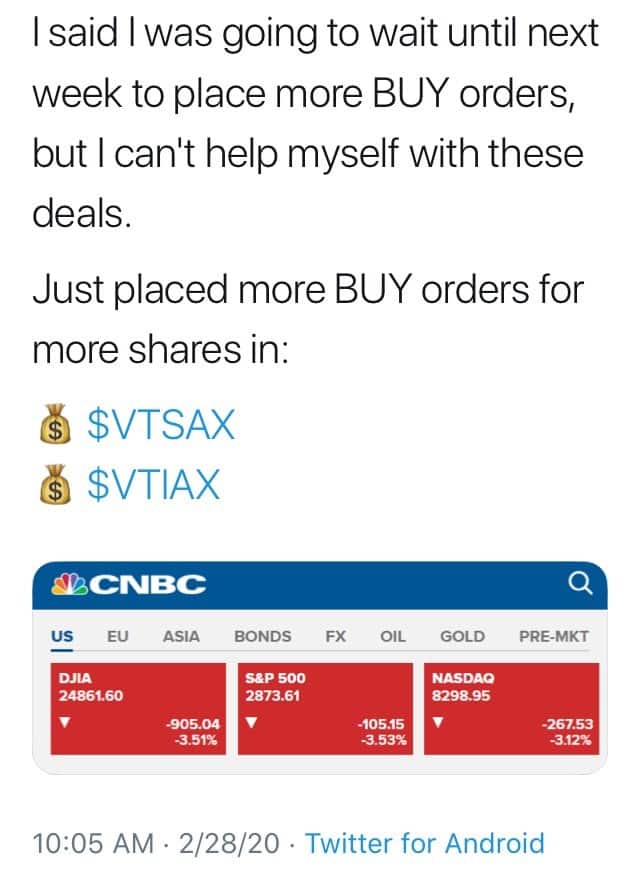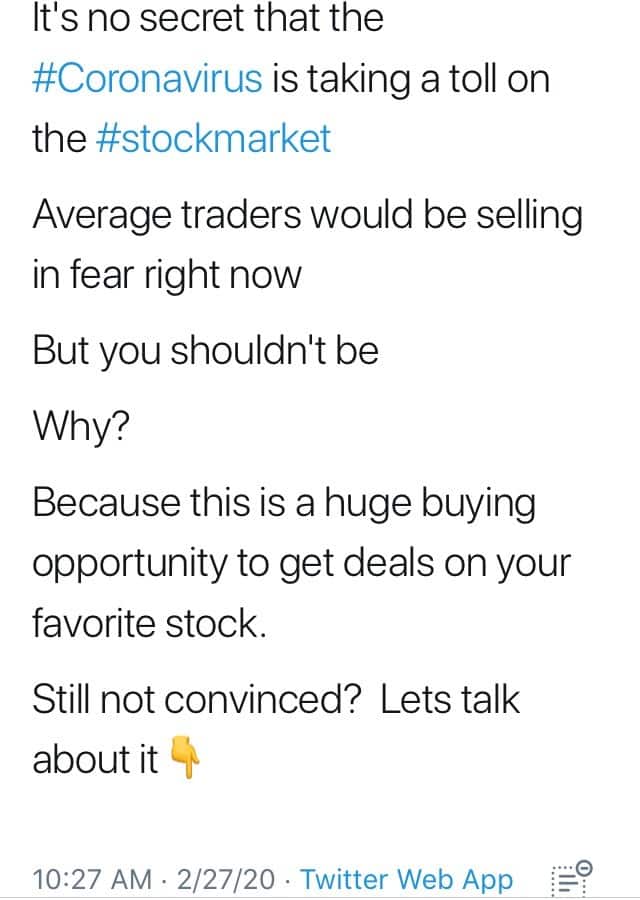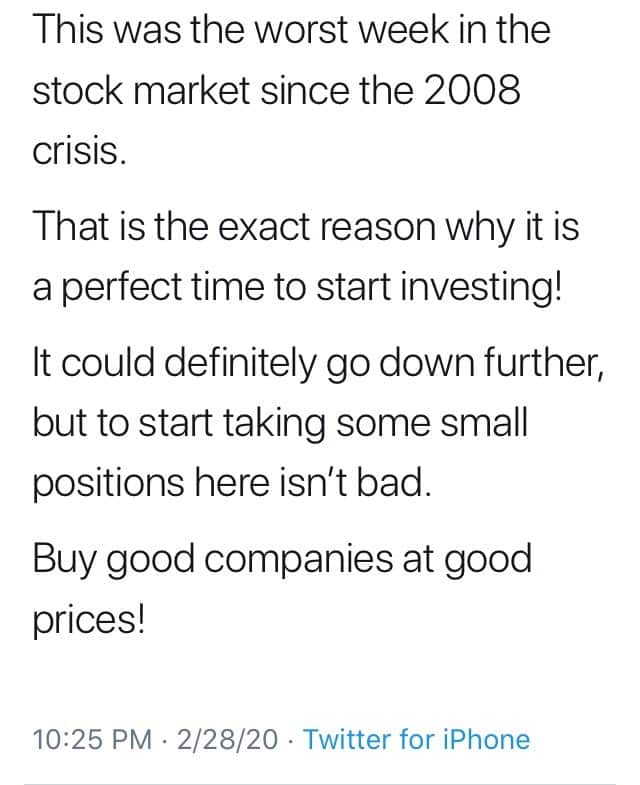Regular reader Bryan‘s advice reminded me why Warren Buffett owns Coca-Cola stock: sometimes, it’s obvious what people want. “What else would you write about this week?” Bryan asked, “Because everyone’s talking about the stock market and coronavirus.”
The human cost of coronavirus is growing. So are the lines at the grocery store. But to stay on theme, I want to focus on how coronavirus is affecting the financial markets, and how common investors are reacting.

On Wednesday February 19th, the S&P 500 closed at a high of 3386.
As of March 1, the S&P had fallen 12.8% from that high, down to 2954.
The Dow Jones had fallen 13.4%, and the Nasdaq 12.7%.
Fast forward through this week, and the market’s daily swings have been up 5%, down 3%, up 4%, and down 4%. It’s a wild ride. Since the total dip is greater than 10%, it’s officially in correction territory.
Related articles talking about market timing:
- Stock Market Success: Luck or Skill?
- How to Time the Market Like a Loser
- Hot Tip! Don’t Handpick Stocks
But let’s start digging in today by examining what exactly the market is afraid of?
Where Does the Price Start From?
Understanding the market’s fear is a complicated topic requiring a circuitous answer. Stick with me here.
It starts with understanding how the market sets its prices in the first place. As I described when discussing the index fund bubble:
Typically, stock market price discovery involves many buyers and sellers conducting detailed analyses of a company’s holdings and profits and cash flows—all of the fundamental business metrics.
…and from that fundamental analysis, out falls a price.
Let’s consider Apple. Apple’s price is set from what buyers and sellers think about Apple’s future earnings, the health of their business, their sales, etc. To distill all that information to a single price, some investors use “dividend discount models.”

If you recall, a dividend is the profit-sharing payout that a company gives to its shareholders. Last year, Apple paid $3.08 per share in dividends. And this year, next year, all future years—Apple will continue to pay a dividend.
Since $3.08 has more buying power today than it will in 2030, investors can “discount” all future dividend dollars back to “2020 dollars” (considering inflation, interest rates, the “cost of capital” etc).
The sum of all those discounted dividend payments provides a good starting point of what a stock is worth. One should then consider the fact that a stock represents physical ownership. An Apple stockholder owns a tiny fraction of each store, each factory, each patent. And that adds to the stock’s tangible value.
How Coronavirus Fear Affects Pricing
Investors are now frightened about how coronavirus might impact Apple’s business. Will Apple meet their 2020 manufacturing predictions? Will there be fewer sales in 2020? How is their workforce holding up?
These questions affect Apple’s financial metrics (profits, sales, etc.), which will likely affect their future dividend payouts and dividend discount models. Therefore, the “correct” price of Apple is falling.
Two weeks ago, we thought coronavirus was on the back foot. Now it appears that it’s spreading more quickly than expected. The stock market’s analyses have fundamentally changed, and prices are reflecting that. Investors are betting that coronavirus is going to make these companies less profitable.
So the prices have dropped. We understand why. How should we react?
Buy? Sell? Hold?
A steady price in the stock market would suggest that there’s an equilibrium between buyers and sellers. Or, in more basic economic terms, that there’s an equilibrium between supply of a stock (from the sellers) and demand for a stock (from the buyers). The two sides of the scale are equal, so the price doesn’t move.
If that’s the case, what does it mean when the market drops 12% in 10 days?
Let’s do an Apple to apples analysis. What might it mean if the price of apples drops at the farmers’ market? It means that either the supply of apples has increased, or that the demand for apples has decreased. Put another way: it means there are too many apples to sell, and not enough apple buyers.
The stock market is no different. On February 19, more people preferred to sell Apple stock at $323 than to buy at $323. At that price, there was more Apple supply than Apple demand. So what did the price do? It dropped.
Sellers were willing to accept a lower price in order to “budge the line” and get Apple stock out of their portfolios.

The same occurred for the next seven weekdays. The fundamental analyses were suggesting that selling at the market’s price was better than buying at that price. The market was not in equilibrium. And since sellers outweighed buyers, the price continued to drop. This was true for Apple, for Microsoft, and for the vast majority of all publicly traded companies.

As a reminder, the market price accounts for the thoughts and feelings of millions of market participants. But how should you and I react?
Enjoying this article? Subscribe below to get new articles emailed straight to your inbox
Thoughts from Twitter
I know, I know. Twitter?!
On a good day, Twitter can be a interesting place to exchange and learn new (albeit brief) ideas. On all the other days, it’s a bazaar of real experts, pseudo-experts, charlatans, and echo chamber influencers sharing their personal re-hashing of already-understood ideas. But this makes Twitter a great place to cherry-pick bad ideas.
There have been some unique Twitter opinions from investment “experts” during the past week of coronavirus panic. Mind you, these aren’t necessarily professional financial planners or hedge fund managers or fiduciaries who are legally obligated to help their clients.
These are Average Joes who may or may not understand what they’re talking about, and who may or may not have your best interest (ooo!) in mind.
Selling magic wands is surprisingly easy, given that they never work.
Shortcuts, hustles, hacks and too-good-to be-true are always in high demand.
Buyer beware.
Seth Godin
And they have usernames like, “All The Stocks – King Dividend – $$$ Get RICH Like Me.” That’s just one name, mind you. I wonder if, “All the Index Funds – Archduke of Fact-based Strategies – $$ Get BORING Like Me” is already taken? Be right back…
See if you can find a pattern in these three Tweets from February 27 and 28:



I want to point out a few shared themes in these Tweets, and then we’ll break those themes down in further detail.
- “They are all selling, but you should be buying.”
- “Trust me, I know what I’m doing.”
- None of these Tweeters discuss where their buying money is coming from. Did they just have a pile of cash in the bank, waiting for a market dip to occur?
Tweet Theme 1: You (yes, you) Should Be Buying
The first common theme of the Tweets is that you should be buying, despite the fact that the market as a whole is selling. I understand the underlying idea here. In fact, it hearkens back to a famous Warren Buffett quote:
Be fearful when others are greedy, and be greedy when others are fearful.
Warren Buffett
In general, markets have a history of over-reacting. That’s what the Mr. Market is all about.
That’s because the market is a group of people, and people tend to over-react. In the past, news stories similar to the coronavirus story have driven prices lower than where they “should” have been, which presented excellent opportunities to buy. Buy low, wait for the market to recover, then sell high. These Tweeters are suggesting that something similar is happening right now. If the markets are fearful, then you should be greedy.
But here’s a pop quiz:
Before February 28th, when was the last time the S&P 500 was at 2950.
That is, when was the last “huge buying opportunity to get deals on your favorite stock?”
Was it before 2008? Or perhaps in 2011 or 2012, during the recovery from the Great Recession? Not quite.
The S&P was last at 2950 in October 2019, just five months ago.
I remember a lot about this past October. I remember writing and working and handing out candy. But I certainly don’t remember all this extra excitement to “buy good companies at good prices.” Instead, it was more common to hear that the market was overpriced and that a recession was just around the corner.
The market was at the same price level then as it is now, which means that the same exact buying opportunities were present. Shouldn’t these Twitter folks have been just as excited about buying then?
Who to Trust?
It should make you realize one of two things. Option 1: these Tweeters are malefactors, trying to take advantage of their followers by selling “shortcuts, hustles, hacks and too-good-to be-true” techniques.
Or Option 2: these Tweeters have good intentions, but are plainly in over their heads. They’re on the shallow end of the Dunning-Kruger curve. (P.S. I think I’m somewhere in the valley of sadness).

In other words, the self-appointed King Dividend is not Warren Buffett.
The claim that “you ought to be buying” should also make you realize: the relative price of the stock is much easier to focus on than the absolute price.
It’s easy to say, “Stocks are 13% cheaper than just one week ago…what a great deal!” It’s much more difficult to ascertain:
- Does 13% off mean that I’m now getting a good deal?
- Was it still a good deal at full price last week?
- Or is it still overpriced? How much lower does the price need to go before I can that good deal?
These are hard questions that you and I probably don’t have the ability to properly assess. And King Dividend doesn’t know either.
Retail Sales and Stock Market Sales
This is a fairly common lesson in personal finance circles. It’s the “myth of the sale.” It’s one of the most common ways that retail stores take advantage of your monkey brain and convince you to buy their stuff. Think about when Sears or Home Depot has a great deal—30% off select items! What’s your reaction?
Most folks would say that the wrong reaction is to think, “It’s like free money—I’m getting 30 cents on the dollar!”
That’s because the right reaction should be, “Do I even want the item that’s on sale? And do I think it’s worth the 70% price?”

Every day, millions of shoppers are making decisions based on the “myth of the sale.” Amazon has “Flash Deals.” The grocery store has two-for-one specials. Black Friday is Black Friday. And in this case, the stock market has dips, scares, or all-out recessions.
If you think a stock is a good buy now, you should look yourself in the mirror—did you feel this way five months ago at the same price? If your answer now differs from your answer in October, then proceed with caution. There might be some faulty irrational logic at play.
Tweet Theme 2: Trust Me—I know what I’m Doing
This is a scary one. I’ve written in-depth about luck and skill and stock market success. Odds are, the person you’re listening to doesn‘t know what they’re doing. Myself included. And I’m an Archduke of Fact-Based Strategies.
When you see someone on the internet telling you to buy or sell or hold, you should wonder: is this person an expert? Am I even knowledgeable enough to determine whether this person is an expert? Or is it just the blind leading the blind? If the answers are unclear, be wary.
Contrarians, by definition, go against the majority flow. The market is selling, but they say buy. It makes them different and cool and edgy, but it doesn’t necessitate that they’re correct.

Am I a hypocrite? Am I giving you advice to not listen to others’ advice, and thus being both meta and contrarian? Maybe, but I don’t think so.
I’m neither listening to the Tweeters, nor offering my own 280 character wisdom. I don’t have prescriptive opinions about what you should do in the face of coronavirus. In my own investments, I’m taking wisdom from giants like Jack Bogle: “Stay the course.”
Staying My Course
For me, “stay the course” means to continue dollar cost averaging into my 401(k) and Roth IRA. I contribute the same amount into my 401(k) every two weeks, and the same amount to my Roth IRA on the first of each month, regardless of the market being up, down, or stable . That’s dollar cost averaging.
If you’re curious, here is exactly how I invest, all laid out for you.
So that means I did buy some index funds on February 26, when the market was down 8%. And I did buy some index funds on March 1, with the market down 13%.
But I didn’t do any special analysis or call my broker. I simply maintained status quo i.e. every other Wednesday and first of the month.
In this particular circumstance, it means I bought during a dip in the market. That’s what dollar cost averaging does. It buys the highs, buys the lows, and probably has the highest ratio of success-to-stress of any method out there.
Tweet Theme 3: Buy!…But With What Money?
All three of my Twitter exemplars are suggesting to buy more stocks or index funds. But where does the purchasing power come from? The average investor would either need to transfer cash to their stock brokerage, or they would need to sell one asset (e.g. a bond) in order to buy another (in this case, more stocks).
And then comes an important question: How long have you been holding cash or bonds while waiting for a stock market opportunity to come along?
To explain more, let’s imagine an investor. Ben has been saving $500 every month since he graduated college in May 2016. He’s been waiting for the perfect opportunity to buy, and he thinks that coronavirus might have provided that opportunity.
Ben Buys In
After all the hubbub last week, Ben decides to dump his $22500 (that’s 45 months of saving) into an S&P 500 index fund.
But then Ben gets curious. What if he had taken a different approach? Instead of putting $500 into a bank account each month and waiting until Feburary 2020, what if he had bought into the S&P each month, little bit by little bit? It wouldn’t be as exciting as a single $22K purchase, but would it have been a better option?
In short, yes. If Ben had dollar cost averaged by buying each month, his portfolio would be worth $25570, instead of $22500. That’s a 13% improvement over Ben’s chosen tactic. And yes, that $25570 total does account for low prices from the recent coronavirus dip.

Here’s an in-depth analysis of many “buy the dip” strategies back-tested against historical market data.
Let’s get back to the real point. In order to buy more stocks, the money has got to come from somewhere. And if that means intentionally holding cash or bonds in order to wait for the “perfect” time to buy, you’re probably going to end up like Ben, losing money on the way. After all, timing the market is a loser’s game.
Conclusions on Coronavirus
Coronavirus is a major concern. It is causing death and illness and fear, and those symptoms ripple across the economy and the stock market. In the moment, it appears that most people are looking to sell. And since there’s proverbial “blood in the streets,” others are looking to buy.
I’m going to maintain my status quo. Since I’ve been “dollar cost average” investing for years, my money is already in the market. I don’t have an extra $10K in cash to throw at the market during this corona dip—and I think that’s a good thing!
But even if I did…why would I be convinced that now is the right time to buy? Why are these prices more appetizing now than they were in October 2019? And am I sure I’m not trying to “catch a falling knife” and get stabbed if the market continues to drop?
It’s much less stressful to approach investing from a passive, lazy portfolio, dollar cost averaging viewpoint. And, it’s pretty easy to convince myself that it’s more profitable too.
While others might be trying to time this viral outbreak for the perfect time to buy, I’d suggest relaxing (with a Corona?) instead.

Thank you for reading! If you enjoyed this article, join 8000+ subscribers who read my 2-minute weekly email, where I send you links to the smartest financial content I find online every week.
-Jesse
Want to learn more about The Best Interest’s back story? Read here.
Looking for a great personal finance book, podcast, or other recommendation? Check out my favorites.
Was this post worth sharing? Click the buttons below to share!
-Jesse Cramer, Archduke of Fact-Based Strategies
Hey Jesse,
This post is pure gold! Unfortunately, most people will never learn or listen. I got at least 3 phone calls from friends since this correction asking what stocks to buy.
I had to disappoint them and explain how my lazy portfolio works. What a boring person I am.
Just chillin with my corona.
Cheers!
Backpack! You’re the ultra fan! Thanks for reading and commenting before I even woke up today 🙂
Don’t worry. Your strategy is ARCHDUKE APPROVED ?
Cheers,
Jesse
Pingback: Viral Stock Market Strategies - The Best Interest - Stay the course!
Pingback: What's Next? - The Best Interest - Future steps, one day at a time
Pingback: A Modest Student Loan Proposal - The Best Interest